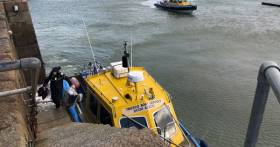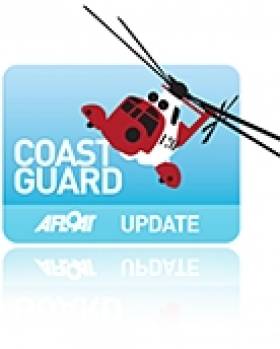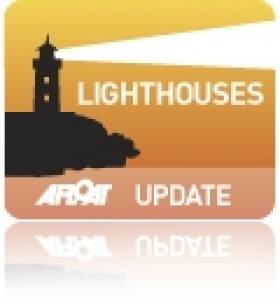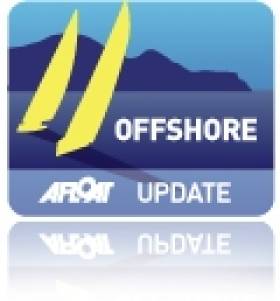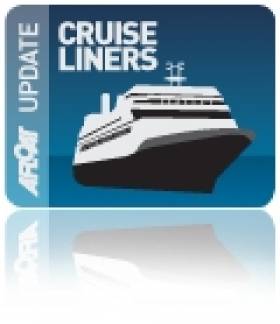Displaying items by tag: Isles of Scilly
Scilly Season Ends, But Islands' Community Meetings Continue on New Vessel Replacement Programme Project
The seasonal Isles of Scilly Steamship ferry service has ended for the year as veteran Scillonian III sailed its last round-trip of Penzance Harbour-Hugh Town, St Mary's, the largest isle of the archipelago off Cornwall, England, writes Jehan Ashmore.
The much-loved Scillonian III with a 485 passenger capacity, had opened the season in April, throughout the summer months and into autumn, however Storm Ciaran led to an abrupt end of the season by the 1977 built passenger and cargo-ship. The last sailing according to the operator’s social media, took place on 31 October, as all the following scheduled sailings were cancelled, day after day given the adverse weather persisted, including on the season’s intended final day, 5 November.
Afloat consulted the operator’s website for next year’s seasonal service, which starts on 18 March. In the meantime, the Steamship continue to operate the year-round essential freight-service by Gry Maritha in addition to passenger ‘Skybus’ services to and from the mainland.
As Afloat previously reported, the Scilly Steamship Group have chosen a French shipbuilder in a £42m contract from private funding for three new vessels to maintain lifeline links to the Isles of Scilly. The newbuilds comprise of a 600 passenger ferry to be named Scillonian IV, a cargo ship and an inter-island freight catamaran which are all scheduled to be in service by March 2026.
The Steamship Group previously held community engagement events on St. Mary’s, the largest of the five inhabited Isles of Scilly, regarding the vessel replacement programme, and they will continue to be held in the outlying islands this month. Members of the Steamship Group will be host along with the new vessels project team which have invited and encouraged island communities to attend.
First of the public meetings resumed yesterday, having begun on Bryher, at the island’s community centre and forthcoming engagement events will be held on the other outlying islands of St Martin’s, St Agnes and Tresco.
With the season of Scillonian III’s sailings concluded, the 1,255 gross tonnage ferry entered the more sheltered inner harbour of Penzance for the winter layover, however it will be by no means a quiet period for the ship’s crew and maintenance team. As the vessel is to undergone routine period of maintenance in preparation for getting all 'ship-shape' in advance of welcoming passengers and carrying freight in Spring, 2024.
As Afloat previously reported, Harland & Wolff Group propose to build new vessels and operate to Scilly, using a passenger ferry, cargo-ship and fast-ferry on the same route between Penzance and St. Mary's. The announcement comes after three years of developing specific designs and a detailed costing model for the newbuilds.
The shipyard group in October held a second series of public consultations on Scilly regarding the company’s proposal to build and operate year-round passenger and freight services connecting Cornwall and the isles.
Harland & Wolff's proposal would put it in direct competition with the established Isles of Scilly Steamship Company which celebrated its centenary in 2020.
Harland & Wolff Host Public Consultation Meetings on Proposed New Isles of Scilly Ferries Programme and Service
This week the Harland & Wolff Group, headed up by CEO, John Wood along with senior representatives, will return to the Isles of Scilly for a second round of public consultations regarding the company’s proposal to build and operate a year-round passenger and freight service between the Islands and Penzance, Cornwall.
The Belfast based shipbuilding group, will also be discussing the company’s plans for a new fast ferry service and freight services following the recent announcement that Harland & Wolff is acquiring local business Kraken Marine Services.
Harland & Wolff believes that the route is significantly underserved by its current operation and that replacing old for new vessels on a broadly like-for-like basis, as currently proposed by the incumbent provider (see Isles of Scilly Steamship Group secure funding for newbuilds), the same problems relating to the lack of availability and intermittent freight service will persist.
The new fast ferry service by Harland & Wolff would cover the summer season between May and September, commencing as early as 2024, and will be able to undertake three round trips daily offering flexibility and increased ‘on-island’ time for visitors.
The Harland & Wolff team have organised events designed to allow residents and businesses to question the company’s team of naval architects, interior specialists and marine engineers about the vessel’s design, operation and bid programme initiated by the Council’s Soft Market Test.
The series of drop in events began yesterday, at The Shop, Quay House, St Mary’s, the largest island of the archipelago. The events continue, as Harland & Wolff will also be at The Shop today (17 Oct.) and Wednesday morning until midday. An additional team will be on St Martin’s also today from 1pm at the Island Hall, and on Wednesday at St Agnes Island Hall from 10am. Further plans have been made to also run a public meeting at the Tresco Community Centre on Wednesday. (Afloat adds that the Isles of Scilly Steamship have held a public meeting last week regards their newbuild programme and will continue with community engagement on out-lying islands next month).
It is Harland & Wolff’s intention that its bid not only stimulates competition for operation of the ferries along this route, but also provides ships that are both innovative and environmentally friendly. The proposed operation would be for an initial five-year period, with the option to extend for a further five years.
John Wood, Harland & Wolff CEO said: “We are excited to have the opportunity this week to speak to Isles of Scilly residents about our exciting proposals and learn more about how we can best deliver ferry services that provide better experiences for the residents and businesses who rely on the routes.
“Harland & Wolff will provide further details of the vessels that we will present in our levelling up bid. These would operate all year round, be built for future infrastructure upgrades and will part of a bid to keep fares affordable for Islanders and visitors alike. The time to change is now, not providing a “like-for-like” service that will see fares spiral for decades to come.”
The Isles of Scilly, an archipelago formed mainly of five larger inhabited islands at a mere 24 nautical miles off Cornwall, England, is simply another world, having recently travelled to with the Isles of Scilly Steamship Company, writes Jehan Ashmore.
It's a place that has grabbed my attention and intrigue, having passed when taking the ferry from Ireland to France. During these overnight crossings to continental Europe, they take a passage in between Scilly and the iconic Land's End on the south-west tip of Britain.
 Scillonian III alongside the quay at Hugh Town, St. Mary's with local inter-island ferries in attendance
Scillonian III alongside the quay at Hugh Town, St. Mary's with local inter-island ferries in attendance
So plans were set in place albeit for a brief visit having booked a day-trip excursion on board the Scillonian III. The 485 passenger ferry which also carries crane-lifted vehicles into its cargo hold, has since 1977 faithfully served islanders and visitors alike for more than four decades on the seasonal route of Penzance Harbour-St. Mary's Harbour. This is located in Hugh Town on St. Mary's, the Isles of Scilly largest inhabited island.
Passengers facilities are predominantly spread on two decks of the 1,255 gross tonnage ferry which features lounges, baby changing room, purser's office and a quiet lounge on the lower deck. As for food and drinks outlets, there is the Western Rocks Coffee Co. located on both the main and upper deck. From here can be accessed the open deck leading to the cruiser stern and on the boat deck is where additional seating is available for sight-seeing. On the deck above is located the funnel amidships, presenting a handsome and traditional profile of the ship registered in Scilly.
 Passengers on deck of the Scillonian III take in the sea air and coastal views
Passengers on deck of the Scillonian III take in the sea air and coastal views
At this stage the seasonal service is well under way having begun in March and continues throughout the summer where visitors can experience and explore the way of life on Scilly. They have a population of around 2,000 where facilities for the islanders and visitors alike on St. Mary's are concentrated in Hugh Town with shops, bank, hotels and a range of other accommodation.
 One of two café lounges, in this case on the upper deck facing forward
One of two café lounges, in this case on the upper deck facing forward
During the 2 hour 40 minute crossing, passengers firstly enjoyed the sights of the rugged Cornish coast where in the distance is the landmark of Porthcurno Beach with its history of many a trans-Atlantic and other submarine telegraph cables laid underneath the sand. Next to the beach and perched on the cliff-face is the impressively positioned open-air Minack Theatre and this was followed by Land's End. While out to sea was another bonus as on the horizon was the Wolf Rock Lighthouse.
All this before the Scilly's would loom into view where secluded sandy beaches dotted the scene interspersed with rocky outcrops. To my surprise woodland was among the features in which visitors can set out to explore these unspoilt isles which have the mildest climate in the UK given a micro-climate influenced by the Gulf Stream, lending to colourful flora and fauna that unfolded as I would soon experience ashore while alongside a coastline of turquoise waters. For the wildlife enthusiast are the puffins which arrive to the Isles to breed between April and July.
On arrival at St. Mary's, Hugh Town with its characterful stone-cut architecture is where bike hire is an option to take in a largely traffic-free environment to further explore the main island. Take in a water based activity be it kayaking to snorkling or visit an archaeological site.
As a first time day-tripper, I decided to take the advice of a seasoned traveller which was to head to Juliet’s Garden Restaurant for lunch while taking in the panorama looking back at Hugh Town. In order to get there, I simply took a walk mostly on the coastal path lined with several beaches where the white sand shone with silvery speckles adding to the allure of the archipelago.
St. Mary's is convenienty also a transport hub with connecting inter-island ferry services (run by other operators) sailing to the inhabited isles of St. Martin's, Bryher, St. Agnes and Tresco which features the sub-tropical Abbey Gardens.
The Steamship company also operate inter-island services using the workboat Lyonesse Lady and likewise of Scillonian III, can handle a vehicle. In addition the Swift Lady, a RIB built by Redbay Boats of Co. Antrim, which provides a postal delivery service as well to acting as a back-up vessel to the Lyonesse Lady.
As for the islanders the freight-coaster Gry Maritha provides an essential life-line service on a year-round basis between the islands and Penzance Harbour.
There are also passenger aviation links in the form of SkyBus services operated by The Isle of Scilly Travel (a trading name of the Steamship company) which provides a service from Land's End Airport to St. Mary's where the airport is closely situated to Hugh Town.
Also in Cornwall are their SkyBus services linking the Scilly's and the UK mainland from Newquay Airport with connecting international airline services to Belfast, Dublin and Cork. Plus there's another SkyBus route through Exeter Airport in Devon that has links to Belfast and Dublin respectively.
For the more intrepid traveller when departing Ireland, a suggested itinerary is to take the ferry service from Cork to Roscoff and spend time in Brittany en-route before heading across the English Channel to Plymouth.
From the city head into the West Country by taking a bus or train to reach Penzance where the Isles of Scilly Travel company offers the option and flexibility of taking the Scillonian III, the SkyBus or a combination of both and in either direction.
Another integrated travel ticket option is with the company and Great Western Railways (GWR) which operates services from Bristol, Exeter and London to Penzance.
New Passenger Ferry and Freight Vessels for Isles of Scilly Steamship Group Is Secured following Private Funding
The Isles of Scilly, off the UK's south-west coast, is to get a new passenger ferry and freight vessels to service the life-line link between the islands and Penzance in Cornwall.
The development follows yesterday's announcement by the Isles of Scilly Steamship Group which has secured a major privately funded ship building programme to replace an existing trio of ageing vessels, among them the Scillonian III.
As Afloat previously reported, the new passenger/cargo ferry (Scillonian IV) and two new freight vessels will set sail by March 2026. The £42m project will be the single biggest investment in the 103-year history of the Company.
The deal will be financed through a £33.6m loan arranged with Lombard NatWest, one of the UK’s largest asset finance providers.
Stuart Reid, Chief Executive of the Isles of Scilly Steamship Group, said the announcement reaffirmed the Group’s long-term commitment to maintaining the lifeline service to the islands, providing certainty, reliability, and a clear timeline for replacing the current ageing fleet.
The Group launched its vessel replacement programme in 2019 to replace its veteran vessel, the Scillonian III passenger ferry, Gry Maritha freight ship and inter-islands launch Lyonesse Lady. At 46, 42 and 32 years old respectively, the existing vessels are coming to the end of their service life, suffer reliability challenges and are increasingly costly to maintain.
In 2021 the Company teamed up with partners on the islands to support a bid to the Government led by the Council of the Isles of Scilly. This saw a conditional offer of £48.5m of Levelling up Funding (LUF) in October 2021 to the Council for new vessels and infrastructure.
However, with no tangible progress made in the last 18 months following the initial offer, significant changes to the terms of the offer and growing frustration with the delay both on and off the islands, the Group has reverted to its original plan of privately financing the new vessels.
Mr Reid said:“The Group has a long and proud history of providing a lifeline route to the islands for more than a century and a dedicated team of experienced staff who understand the unique nature of the islands and the needs of its residents and businesses.”
“We are delighted to be announcing this major investment for the islands which will see vessels coming into service by March 2026. These new vessels will deliver a significant improvement in sea link services for the community and the visitor market. It provides certainty for islanders, island businesses and visitors, and the more than 200 staff that we employ on the islands and the mainland.”
The Scillonian III carries over 110,000 passengers a year and operates an essential service for both islanders and the islands’ predominantly tourist economy.
The striking new 72-metre Scillonian IV passenger ferry will carry 600 passengers (an increase of 115) over three decks with a contemporary, comfortable seating arrangement, onboard coffee shop and retail area.
It will reduce journey times, improve comfort with anti-roll fins to improve the stability of the crossing, and feature increased cargo capacity with the ability to carry higher volumes of chilled and frozen goods and improved access for passengers with reduced mobility.
Every year 15,000 tonnes of cargo are shipped to and from the Isles of Scilly. The 45-metre dedicated cargo ship to replace the Gry Maritha will have an increased cargo capacity, including more space for chilled and frozen goods and a crane which can lift eight tonnes. The new cargo vessel will have a comfortable lounge for a small number of passengers, and this will provide more travel options throughout the winter months to island residents.
The new inter-island launch will allow for faster journey times between St Mary’s and the off-islands. It will have a 50% increase in cargo capacity and a significantly reduced fuel consumption. The aluminium catamaran design will also improve access into tidal restricted off-island quays.
All three vessels will have fuel-efficient engines which will reduce emissions while providing an enhanced service and improved resilience for the Islands. The vessels will be designed and built so that they can be retrofitted with improvements in green propulsion technology when mature and proven.
Ian Howard, Chairman of Isles of Steamship Group said:“When the current Board took over in 2019, its first priority was to restore profitability and put the Company in a position where it did not have to be reliant on hand outs. We have done that. The next step is to bring in new ships which will enhance the service to the islands for passengers and for islanders’ freight needs. This is a special moment for the Company and the islands.”
Nathan Sikorski, Director, Lombard, NatWest Group said:“The Lombard team of Chris James and I are delighted to have been given the opportunity by the Isles of Scilly Steamship Group to become a key partner in delivering on this exciting new-build project, which will see the sustainability of this critical lifeline service continue for generations to come.
“Lombard’s support for the Isles of Scilly Steamship Group dates back many years having facilitated the acquisition of the original Gry Maritha. This exciting major investment will transform its fleet of vessels and secure the long-term future of the vital services it provides.”
The Steamship Group is in discussions with several shipyards and next steps will be to finalise procurement and build programmes.
Wait is Nearly Over: Isles of Scilly Votes Arrive by Boat for Final UK Election Constituency
In the UK, ballot boxes for the final General Election constituency to announce its results are on their way to be counted after stormy conditions passed.
In the constituency of St. Ives (Cornwall), adverse weather had meant boats and a Royal Naval Air Service helicopter from the outer islands of the Isles of Scilly were unable to reach the main island of St Mary’s.
Andrew Walder, a skipper for Tresco Boats, ferried the final votes from St Martin’s and St Agnes this Friday morning after conditions had “much improved”.
For more the Irish Examiner reports including footage from onboard the inter-island boat trip.
#Coastguard - Two helicopters from the Irish Coast Guard's new long-range rescue fleet were dispatched in a multi-agency response to a sunken fishing trawler off the Isles of Scilly in the early hours of this morning (Tuesday 19 May).
As TheJournal.ie reports, the coastguard's Rescue 115 from Shannon and Rescue 117 from Waterford were both tasked to respond to the emergency 75 miles west of the islands off the tip of Cornwall in south west England – themselves some 150 nautical miles south of Waterford.
Luckily the trawler's skipper and five crew were picked up from their liferaft by passing Irish trawler Cu Na Mara, on which they are expected to reach Castletownbere this afternoon.
TheJournal.ie has more on the story HERE.
When Irish Lights Are Shining in the Scilly Isles
#IrishLightsScilly – ILV Granuaile, the Commissioners of Irish Lights aids to navigation tender is understood to have carried out work for the first time within waters of the Isles of Scilly, writes Jehan Ashmore.
The tender's call in this week of St. Patrick's Day followed a departure from Irish waters in which she has responsibility around the entire coast of this island.
It was when she headed through St. Georges Channel is where she passed in the opposite direction the containership Coronel. The only vessel that operates between the Irish and Welsh capitals had departed Cardiff bound for Dublin.
ILV Granuaile has worked previously off the UK's South West coast but prior to this area she headed into the Bristol Channel to call into Swansea Docks where Trinity Lights have a depot in King's Dock. Likewise of Irish Lights, the general lighthouse authority (GLA) of Trinity House has responsibility for the safety of shipping and mariners in waters off England, Wales and the Channel Islands.
Following an overnight call, she was off Porthcawl. She then took a longer passage across the Bristol Channel to pass off Ilfracombe and offshore of the estuary leading to Appledore. This is where the Navy Service latest newbuild OPV90 was built by Babcock Marine. As reported before, James Joyce had completed recent builders sea-trials.
So why was ILV Granuaile working off the Scilly Isles, the reason is that one of the trio of Trinity House vessels, THV Patricia is undergoing her special five-year drydock in Hull. Last year ILV Granuaile underwent a more extensive 15 year Special Survey and Drydocking' at Cork Dockyard.
During her Scilly stay and offshore of Hugh Town on the largest island is where the main freight-only cargship, Gry Maritha was operating.
Both vessels this afternoon departed for the mainland, with the cargoship calling within the small confined dock of Penzance Harbour. Whereas the Irish lighthouse tender took up a position offshore of the Cornish port.
In January, Northern Lighthouse Board, the third GLA, deployed NLB Pole Star that involved a brief call to Dun Laoghaire Harbour. The call of the tender which otherwise has juristriction along with NLB Pharos of Scottish and Manx waters was concurrent to the 'Granuaile' making a more recent call to Cork Dockyard last month.
Missing Solo Sailor Airlifted To Cork Hospital
#Offshore - BBC News reports that a sailor who went missing last week during a solo voyage from Plymouth to Portugal has been located and airlifted to hospital after falling overboard.
The 66-year-old man set off last Monday 10 June but apparently suffered chest injuries during the first night.
Falmouth Coastguard has difficulty contacting the man to determine his position but he was eventually found some 225km off the Isles of Scilly. He was later transported by helicopter to Cork for treatment.
First Cruise-Caller of the Year
Onboard the ship which caters mostly for the UK market, asides the interior facilities there are the outdoor leisure amenities located on the Lounge Deck which has two jacuzzis and an exercise pool. There is also a large swimming pool and weather permitting a poolside buffet is also available at meal times. In addition a circular pool is located on the Marque Deck.
She alongside sister Black Watch belong to a four-ship fleet of the Norwegian owned company. Boudicca was built in 1973 and for many years served as Royal Viking Star as part of a trio of German built sisters for Royal Viking Line. The 205m long vessel underwent her last major refit in 2006.
Boudicca will remain berthed in Dublin's Alexandra Basin until she sets sail later this afternoon for the short overnight cruise-leg to Liverpool.
Last year Dublin Port handled 88 cruisecalls and this number of cruise-callers is to be closely repeated in 2011. Overall there will be over 200 cruise calls with around half a million passengers and crew scheduled to visit ports and anchorage locations throughout the island of Ireland. The cruise sector business is estimated to generate €60m to both the northern and southern economies.


























